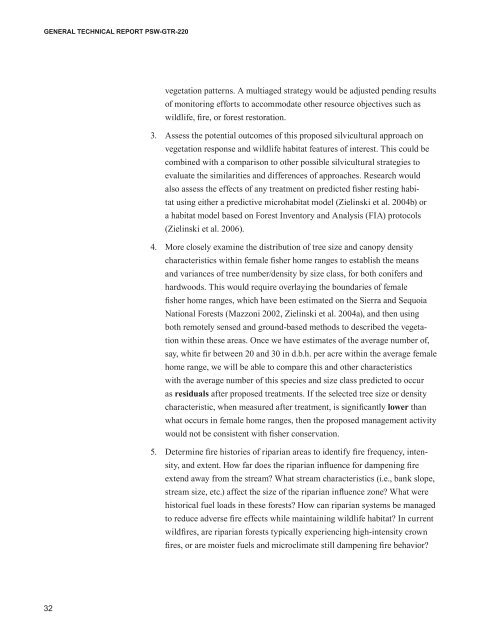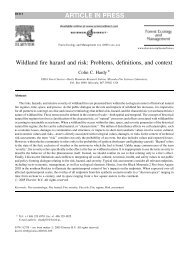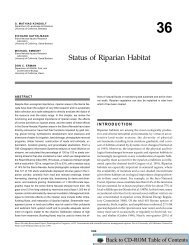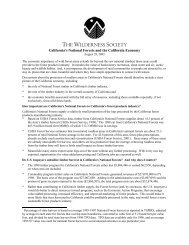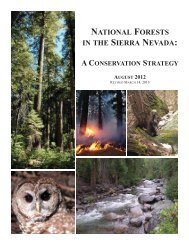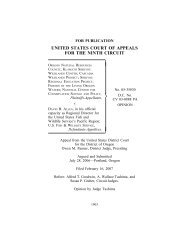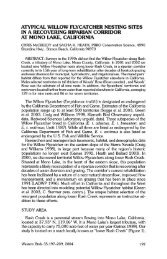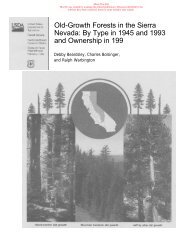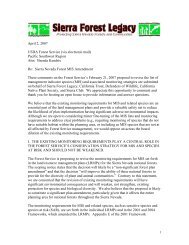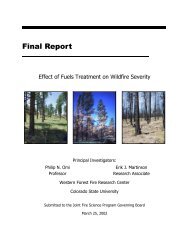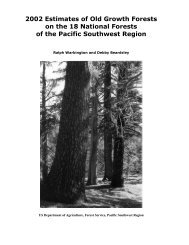An Ecosystem Management Strategy for Sierran Mixed-Conifer Forests
An Ecosystem Management Strategy for Sierran Mixed-Conifer Forests
An Ecosystem Management Strategy for Sierran Mixed-Conifer Forests
You also want an ePaper? Increase the reach of your titles
YUMPU automatically turns print PDFs into web optimized ePapers that Google loves.
GENERAL TECHNICAL REPORT PSW-GTR-220<br />
vegetation patterns. A multiaged strategy would be adjusted pending results<br />
of monitoring ef<strong>for</strong>ts to accommodate other resource objectives such as<br />
wildlife, fire, or <strong>for</strong>est restoration.<br />
3. Assess the potential outcomes of this proposed silvicultural approach on<br />
vegetation response and wildlife habitat features of interest. This could be<br />
combined with a comparison to other possible silvicultural strategies to<br />
evaluate the similarities and differences of approaches. Research would<br />
also assess the effects of any treatment on predicted fisher resting habitat<br />
using either a predictive microhabitat model (Zielinski et al. 2004b) or<br />
a habitat model based on Forest Inventory and <strong>An</strong>alysis (FIA) protocols<br />
(Zielinski et al. 2006).<br />
4. More closely examine the distribution of tree size and canopy density<br />
characteristics within female fisher home ranges to establish the means<br />
and variances of tree number/density by size class, <strong>for</strong> both conifers and<br />
hardwoods. This would require overlaying the boundaries of female<br />
fisher home ranges, which have been estimated on the Sierra and Sequoia<br />
National <strong>Forests</strong> (Mazzoni 2002, Zielinski et al. 2004a), and then using<br />
both remotely sensed and ground-based methods to described the vegetation<br />
within these areas. Once we have estimates of the average number of,<br />
say, white fir between 20 and 30 in d.b.h. per acre within the average female<br />
home range, we will be able to compare this and other characteristics<br />
with the average number of this species and size class predicted to occur<br />
as residuals after proposed treatments. If the selected tree size or density<br />
characteristic, when measured after treatment, is significantly lower than<br />
what occurs in female home ranges, then the proposed management activity<br />
would not be consistent with fisher conservation.<br />
5. Determine fire histories of riparian areas to identify fire frequency, intensity,<br />
and extent. How far does the riparian influence <strong>for</strong> dampening fire<br />
extend away from the stream? What stream characteristics (i.e., bank slope,<br />
stream size, etc.) affect the size of the riparian influence zone? What were<br />
historical fuel loads in these <strong>for</strong>ests? How can riparian systems be managed<br />
to reduce adverse fire effects while maintaining wildlife habitat? In current<br />
wildfires, are riparian <strong>for</strong>ests typically experiencing high-intensity crown<br />
fires, or are moister fuels and microclimate still dampening fire behavior?<br />
32


